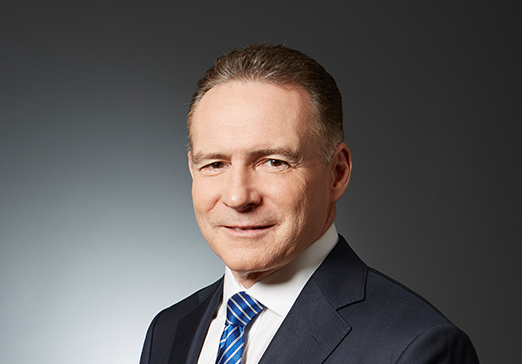Q4 2023 and Year End Strategy & Market Reviews
Each quarter, our Investment Management teams publish their key observations and portfolio updates across Global Equity and Fixed Income markets. This is a summary of our views for the Fourth Quarter of 2023. You can download the full reports via the links shown below.
KEY OBSERVATIONS
After declining -10.3% from its July 31, 2023 high, the S&P 500 increased or rallied +15.9% between its October low and the end of the year. We believe this reversal reflects at least three market headwinds that appear to be shifting into rather potent tailwinds.
The first tailwind is what many are calling the “Fed Pivot.” In December, the US Federal Reserve did not raise interest rates for a third consecutive meeting, and more importantly, the median projection for the Fed Funds target rate was lowered for 2024 and 2025. We are now almost certainly at the peak of the interest rate cycle. The bottom line is that it looks like the Fed is now clearly on the side of those who own stocks.
The second tailwind is an improving inflationary and economic picture. Also in December, the Fed’s preferred measure of inflation showed a month-over-month decline for the first time in over three years. Hovering at 2.6% year over year, inflation is not quite at the Fed’s long-run target of 2%, but moving in the right direction. When combined with easing GDP growth, inflation appears to be shifting from a headwind to a moderating tailwind – and without a recession.
The third tailwind is stronger corporate earnings. Profit growth among S&P 500 companies decelerated throughout 2022 (meaning it grew, but at a slower pace). It contracted from Q4 2022 to Q2 2023 (meaning earnings fell). But in Q3 2023, earnings grew +5.8%. We are awaiting results for Q4 2023, but the consensus is that we are now likely entering a phase of sustained earnings growth.
It appears that three of the market’s most significant recent obstacles are now supportive factors. Further, the current bull market is still young from a historical perspective, and judging by previous bull markets, there may be considerably more length and strength to this bull run.
In any event, an environment of falling interest rates on the back of better inflation prospects and higher earnings growth is a combination of tailwinds that cannot be ignored.
NORTH AMERICAN EQUITY UPDATE

Peter Jackson, HBSc, MBA, CFA
Chief Investment Officer
Portfolio Manager, North American Equities
During the fourth quarter, the S&P500 total return was +11.7% in US dollars or +8.9% in Canadian dollars. The TSX total return was +8.1% in Q4.
Our overall equity exposure increased marginally from 94% to 95% with cash declining from 6% to 5%. We shifted our allocation in favour of US equities (+5%) over Canadian equities (-4%) with cash making up the difference.
Canadian real GDP growth declined -1.1% annualized during the third quarter of 2023 and the latest report for October pointed to little rebound so far for the fourth quarter. About 60% of all outstanding mortgages in Canada will come due over the next three years, which will create a further drag as consumers refinance at potentially much higher rates. It is worth noting that most of our Canadian holdings have international revenue, thus limiting our true exposure to the economic environment in Canada.
We added three new investments during the quarter:
Walmart and Amazon: These investments share three key metrics that we think define their respective competitive advantages today: 1) revenues growing faster than their peers and taking additional market share, 2) profitability is starting to turn higher, and 3) valuations at current levels are attractive.
In the case of Walmart, the company wins in almost any economic environment. Consumers turn to Walmart during inflationary times to stretch their purchasing power. As inflation subsides, it will likely lead in lowering prices, which should drive increased traffic and unit growth.
In Amazon’s case, before the pandemic, the company was only starting to become profitable. During the pandemic, it had to invest heavily to overhaul its distribution network, which weighed on its profitability. We believe the bulk of the investment is over and that it will now benefit from higher profitability.
Vertex Pharmaceuticals has a global monopoly in cystic fibrosis treatments, which has led to industry-leading sales and profitability, along with an exciting pipeline of other potential therapies, including a non-addictive pain treatment with the potential to compete with opioids.
A detailed review of each company can be found in the full report per the link above.
GLOBAL EQUITY UPDATE

Phil D’Iorio, MBA, CFA
Portfolio Manager, Global Equities
After a tumultuous 2022, in which both stocks and bonds fell by double digits, stocks came roaring back in 2023. Some of the factors behind this strength were low expectations, the absence of a global recession, and a faster-than-expected decline in the rate of inflation.
The U.S. proved to be more resilient than expected in 2023, driven by a robust labour market, continuing COVID stimulus, and legislation such as the Inflation Reduction Act and the CHIPS Act. We believe that the probability of a soft landing in 2024 has increased in light of this economic strength, combined with falling global inflation and expected interest rate cuts.
A high dependence on imports and exports hurt the Eurozone economy in 2023. Germany contracted in the third quarter, which is worrisome given its status as the region’s largest economy. Its vast manufacturing sector has struggled due to weak demand from China, elevated energy costs, and significantly higher interest rates. The Eurozone economy should gradually pick up as consumption recovers and inventories are rebuilt.
Going into 2023, expectations for China were high as it reopened following the COVID lockdowns that crippled the economy for over two years. However, the optimism faded quickly as concerns about the country’s real estate problems resurfaced. Although we expect China to remain weak as 2024 begins, its government has announced a series of stimulus measures and we believe that the economy is in a bottoming process.
Japan was a bright spot for global equity investors in 2023. The country appears to have emerged from three decades of economic stagnation as the economy expanded at an above-trend pace in both nominal and real terms during 2023. Given that approximately 50% of public companies in Japan are trading at less than 1x book value, there is substantial room for share price appreciation as companies improve their capital efficiency and profitability. We are optimistic about the prospects for Japan going forward.
We added several new investments across a variety of industries during the quarter, including Amazon and TFI International in the Global Strategy portfolio, and Keyence, Partners Group, Sage Group, Universal Music Group, and Wolters Kluwer in the International portfolio.
A detailed review of each company can be found in the full report per the link above.

Owen Morgan, MBA, CFA
Portfolio Manager, Fixed Income
The last quarter of 2023 rewarded fixed income investors for their patience after a challenging first nine months of the year. The FTSE Universe Canada Bond Index gaining +8.27% for the quarter, bringing the YTD figure to +6.69%. November saw the bond market’s second-largest monthly gain in over 20 years, and the rally continued in December.
A confluence of factors drove these returns. The US released a string of weaker-than-expected economic data, which hinted that the economy was cooling, suggesting the need for rate cuts. Canadian economic data was more mixed, with November producing a weaker jobs report and slightly negative GDP, although this was offset by a big upward revision to Q2 GDP and a stronger December jobs report.
From a fixed income investor’s perspective, 2024 will be spent focusing on timing the first rate cut by the central banks. As of this writing, the market expects the first US rate cut to occur in March and the first Canadian cut to take place in the spring. Our suspicion is that central bankers will be more cautious than widely anticipated. In our view, the first cut by the Fed will likely occur in May or June, and that it will be a modest 25 bps to begin with. We believe that the Bank of Canada will ultimately cut before the Fed does, largely due to the softer state of our economy.
In terms of positioning our portfolio, extending the duration will benefit the fund if the anticipated rate cuts do materialize. Even in the absence of rate cuts, extending duration will not impact investors negatively should rates remain relatively static. In addition, given that the odds of a Canadian recession, albeit mild, have risen in our view, modest increases in weights in federal, provincial, and/or investment grade corporate bonds are prudent.
We consider corporate bond spreads (the additional yield corporate bonds earn over Government of Canada bonds) to be a good indicator of financial stress. These spreads tightened throughout 2023, which is a sign of bullish sentiment toward corporate debt and does not indicate the expectation of a significant recession.
In summary, absent a major unforeseen shock, we believe 2024 will provide a constructive environment for fixed income investors.



